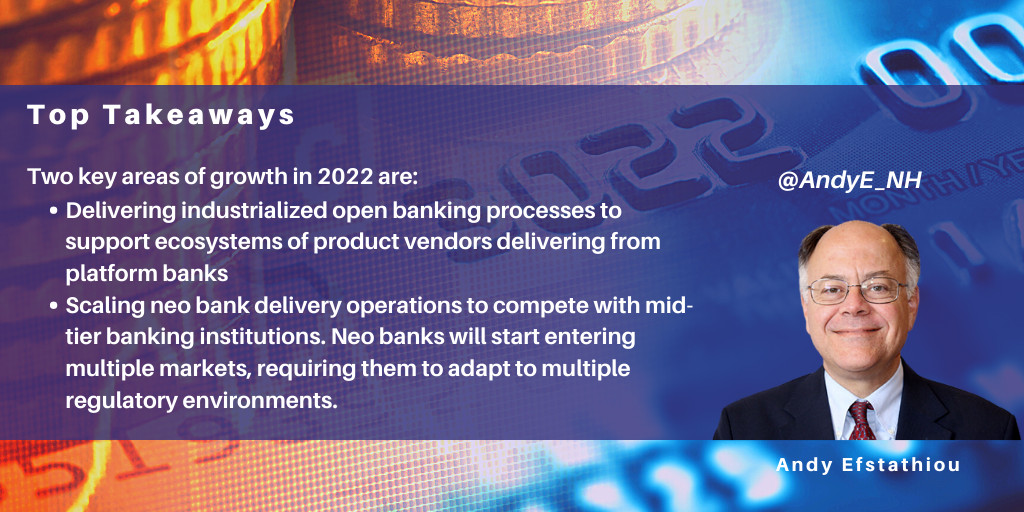posted on Jan 11, 2022 by Andy Efstathiou

In 2022, the financial industry will continue to focus on building out its cloud and digital services infrastructure. This will be a deepening of capabilities for banks that have started their transformation, and the start of the journey for institutions that have not yet initiated their transformation. The growth rate of digital transformation is very high at ~20%.
Since most technology services vendors now derive 40% to 60% of their revenues from digital transformation services, this high growth rate will build on a large revenue base. However, there are two areas that have small revenues but much higher anticipated growth rates. We predict that these areas will start to make an impact in 2022, and be the growth engine for IT services in the financial industry in three to five years. They are:
- Delivering open banking processes in an industrialized environment
- Scaling neo bank delivery.
Our discussions with bank executives indicate that these are high priorities, though they also highlight a lack of consensus, with a wide range of perceptions. However, it is clear that execution will need third-party vendors to support and provide rapid, effective, and scaled services.
Industrializing Open Banking Delivery
Open banking has been a regulatory initiative for five years, but is only now moving to the execution stage in a few markets. Advanced markets moving ahead today include the Nordics and Benelux. These smaller markets make experimentation more feasible for a bank to launch a full-scale open banking initiative, and it is also easier to reengineer operations on the fly based on customer feedback. And, in smaller markets, it is easier for the financial institution to design an offering for a new customer demographic and vet partners to deliver a quality customer experience.
Delivering successful customer experiences in the initial open banking initiatives will drive customer awareness and willingness to adopt new offerings. Currently some Nordic banks are pursuing initiatives (e.g. in small business markets) which, if successful, will enable them to capture very large market shares of new customer demographics. The key is these markets are all domestic. It is rare that a bank in a mature market can pursue a domestic market opportunity as large as its existing markets.
Scaling Neo Bank Operations
Startup digital banks (neo banks) focus on their business model and the design and creation of new banking products. Ongoing operational delivery is not considered to be a core competency. Neo banks have been around for five plus years, but many have failed and just a few, such as Marcus, have grown to considerable size. None to date have become a tier one bank or financial services provider. Each market has seen different types of startup financial institutions opened. In the U.S., payments vendors have predominated; in Europe, digital banks have been the predominant form of startup.
The financial institutions (i.e. banks, payments processors, lenders such as Marcus, Revolut, Stripe, or Square) that have grown since founding must now scale up operationally to drive home their digital advantage before competitors match their digital value proposition. Scaling their business does not just mean scaling transaction processing, it requires scaling control, compliance, and security. Third-party BPS vendors are required to support this transition to large-scale, multi-product, multi-market operational delivery. Vendors that can provide combined domain-specific ITS and BPS services are rare. In 2021, BPS services grew slowly as clients focused on ITS for digital transformation. In 2022, BPS services focused on supporting neo bank growth will provide most of the growth in banking BPS revenues.
Summary
Financial institutions have been experimenting with new business models and customer methods. In 2022, these initiatives will need to scale the business, not just the transactions (which hyperscalers have been doing). Delivering domain-relevant operations at high scale will become an emerging focus of the digital financial industry for the next five years and drive large revenues for vendors who can deliver these comprehensive services.
